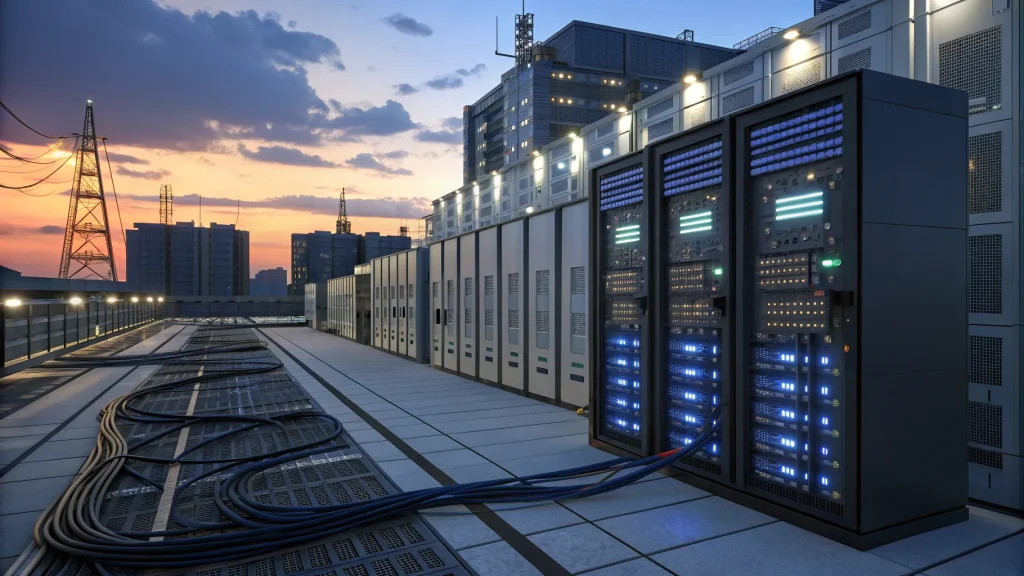AI looks simple on the surface. You type a prompt. You get an answer. But the hidden engine is huge. It is powered by thousands of servers that run nonstop. Those servers sit in data centers that need massive amounts of electricity. We do not have the power infrastructure ready for this surge. That shortfall is starting to cause social and political pushback.
Table of Contents
ToggleWhat It Takes to Power AI
I have worked in finance and tech for years. As a CIMA and CFP, I study how trends ripple into jobs, costs, and local budgets. The truth is plain. AI runs on energy. Every chatbot reply is the result of heavy computational work. Those cycles happen in vast buildings stacked with server racks. Cooling systems hum around the clock. Backup systems sit ready. The electric load is immense and rising.
Think of it like a new factory, but instead of steel and smoke, it is silicon and heat. The grid must deliver a steady stream of power. The wires must carry it. The transformers must handle it. If any link is weak, neighbors feel the strain. Bills can rise. New lines take years to permit and build. Timelines collide with the pace of AI growth.
“You go type something in a ChatGPT and it spits out a phenomenal answer for you. Well, that’s all predicated upon a massive warehouse somewhere that has stacks and stacks of servers.”
View this post on Instagram
Where Pushback Starts
I lived in Indianapolis for about five years. On the southeast side, there is a community called Franklin Township. It is a middle-class area that needs jobs. A major tech firm stepped up. Google talked about placing a billion-dollar data center there. On paper, it looks like a win. Big investment. Many new roles. A boost to local spending.
The response was not what you might expect. Some residents pushed back. They worried about power costs. They feared that a data center would soak up electricity and leave them with higher bills. The offer of jobs did not erase that fear. They were wary of being the ones who pay for upgrades while a giant company enjoys cheap power.
“They should be jumping up and down saying, yeah. We’ll take those 10,000 jobs. They’re like, no, we’re good because they’re scared of what’s gonna happen to their electricity bill as these data centers just suck electricity out of the system.”
Why Communities Worry
These worries make sense. Power is not an infinite resource. Utilities plan demand years ahead. Sudden large loads can force quick upgrades. Someone must pay for that. Often it is spread across ratepayers. People who live nearby see the risk first. They do the math for their own homes and small businesses. If bills rise by even a small percent, it hurts. Every dollar counts in a tight budget.
A data center also competes with other growth. A factory, a school, or a hospital might need more capacity too. When a giant user moves in, the grid must stretch to meet it. If the stretch is not ready, other projects stall or get pricier. That is when local politics heat up. Leaders face pressure from both sides. Take the jobs or protect ratepayers. Move fast or wait for more lines and plants. There are few easy answers.
Key Points to Keep in Mind
- AI relies on huge data centers that draw steady, heavy power.
- Many grids were not built for this sudden growth in demand.
- Local communities fear higher bills and infrastructure delays.
- Even big job offers can face resistance if power costs rise.
- Clear plans on who pays and how fast upgrades arrive matter.
The Hidden Costs of High-Tech Growth
We are watching a classic trade-off. Growth brings jobs and tax receipts. It also brings stress to public systems. Power is the first system to feel it. Water, roads, and emergency services can follow. If a site needs special lines or a new substation, the price tag is large. The timeline is long. Lawsuits can slow it further. Voters do not have patience for open-ended promises.
Companies need predictability too. They build to long-term plans. They want low power prices and fast hookups. They want permits on a set schedule. When those needs clash with local limits, projects drift. The risk is that investment moves to places with stronger grids or more flexible rules. That can leave some regions behind. It can also push projects to rural areas with fewer ratepayers to share costs.
How to Balance Jobs and Bills
There are practical ways to reduce the strain. None is perfect on its own. Together, they can make a deal work better for both sides.
One path is to align siting with power supply. Pick locations near strong transmission. Use sites with access to existing substations and room for expansion. Many utilities map these zones. They know where spare capacity sits and where it is tight. Companies should plan with those maps from day one.
Another path is to match use with generation. Some data centers sign deals to add new supply. They can back local solar, wind, or gas plants that are built for the project. They can add storage for peak hours. This does not solve every problem. It can ease the load and signal good faith.
Demand timing helps too. Data centers can shift non-urgent jobs to off-peak hours. They can curtail during extreme peaks. They can install on-site backup to ride out stress on the grid. These steps turn the site from a rigid user into a flexible one.
Fair cost sharing is key. Communities want to see that they are not left holding the bag. Firms can agree to fund a share of new lines or equipment. Regulators can set rates that shield small users from big spikes tied to one project. Clear contracts help, and they build trust.
What This Means for Investors and Workers
As an adviser, I watch where capital flows. AI is drawing huge sums. It needs chips, cooling, land, and most of all, power. Utilities that can add capacity on time and on budget will see demand. Grid equipment makers will stay busy. Regions with room in their networks will win placements. Regions that drag may lose out.
Workers should look at the full life cycle. Data centers employ builders during construction. They hire tech staff to run operations. They also spur jobs in security, maintenance, and local services. But the headcount varies by site. A huge facility may not employ as many people as a large factory. Communities should ask for clear headcount plans and training support. Good local schools and workforce programs can turn promises into paychecks.
What I Saw in Indianapolis
Franklin Township taught me how this plays out. Neighbors wanted growth, but not at any cost. They wanted to know how power bills would change. They wanted to know who pays for new lines. They wanted timelines, not talking points. That is a fair ask. Big projects should come with plain terms. Simple math. Clear dates.
It is not anti-tech to ask for that. It is responsible. AI is here to stay. It will reshape many parts of our lives. But it should not push quiet communities into sudden rate shock. It should not arrive without a plan to keep the lights on for everyone.
What Companies Should Do Next
Tech leaders can help lower the tension. Start community talks early. Share load forecasts in plain language. Explain cooling needs and noise controls. Offer site tours of similar facilities. Bring utility partners to the table. Show how upgrades will be paid for and when they come online. Put it in writing.
Transparency turns fear into facts. It gives local leaders cover to say yes. It helps utilities design the right fixes. It makes a project stick, rather than stall under pressure. Most of all, it respects the people who live with the outcome after the ribbon is cut.
Why This Moment Matters
The next few years will set the pattern. If we rush and ignore grid reality, we will see more backlash. If we plan, we can add AI capacity while keeping bills in check. This is not about being for or against tech. It is about smart growth. Build where power exists or can be added on a clear path. Share costs in a fair way. Keep neighbors in the loop. Do that, and the jobs and the lights can coexist.
AI will keep growing. The question is where and how. Communities like Franklin Township are showing that local voices matter. I expect more towns to ask the same hard questions. That is healthy. It pushes better deals and better engineering. In the end, strong grids and clear plans will be the true enablers of AI.
As I weigh the risks and rewards, I come back to one simple idea. Power is the fuel of modern life. If we respect that limit and plan around it, AI can scale without punishing the people who live next door.
Frequently Asked Questions
Q: Why do AI data centers use so much electricity?
They run rows of high-performance servers and cooling systems without long breaks. That constant computing and heat removal create a significant, steady power demand.
Q: How can a town protect itself from higher power bills?
Ask for clear cost-sharing plans, phased grid upgrades, and rate structures that limit pass-through costs to households. Early, transparent agreements help prevent surprise increases.
Q: What should companies offer communities during siting talks?
Provide load forecasts, construction timelines, infrastructure funding details, and local hiring and training plans. Commit to demand management and on-site backup to ease grid stress.

















